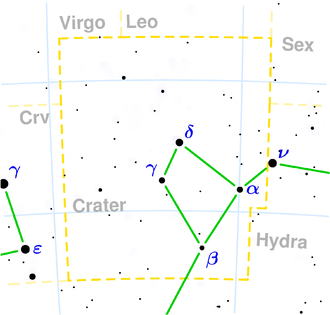NGC 3597
| Galaxie NGC 3597 | |
|---|---|
 | |
| NGC 3597[1] (Hubble-Weltraumteleskop) | |
| AladinLite | |
| Sternbild | Becher |
| Position Äquinoktium: J2000.0, Epoche: J2000.0 | |
| Rektaszension | 11h 14m 41,97s[2] |
| Deklination | -23° 43′ 39,7″[2] |
| Erscheinungsbild | |
| Morphologischer Typ | S0+: / pec / HII[2] |
| Helligkeit (visuell) | 12,7 mag[3] |
| Helligkeit (B-Band) | 13,6 mag[3] |
| Winkelausdehnung | 1,8′ × 1,4′[3] |
| Positionswinkel | 64°[3] |
| Flächenhelligkeit | 13,6 mag/arcmin²[3] |
| Physikalische Daten | |
| Zugehörigkeit | isoliert[2] |
| Rotverschiebung | 0,011675 ± 0,000003[2] |
| Radialgeschwindigkeit | 3500 ± 1 km/s[2] |
| Hubbledistanz vrad / H0 | (148 ± 10) · 106 Lj (45,4 ± 3,2) Mpc [2] |
| Geschichte | |
| Entdeckung | John Herschel |
| Entdeckungsdatum | 21. März 1835 |
| Katalogbezeichnungen | |
| NGC 3597 • PGC 34266 • ESO 503-003 • MCG -04-27-005 • IRAS 11122-2327 • 2MASX J11144196-2343396 • SGC 111214-2327.4 • GC 2351 • h 3333 • GALEXASC J111442.00-234340.8 • NVSS J111441-234338 • WISEA J111441.97-234339.5 • 2MIG 1558 | |
NGC 3597 ist eine Linsenförmige Galaxie vom Hubble-Typ S0/a[3] mit ausgedehntenSternentstehungsgebieten im Sternbild Becher südlich des Himmelsäquators. Sie ist schätzungsweise 148 Millionen Lichtjahre von der Milchstraße entfernt und hat einen Durchmesser von etwa 85.000 Lichtjahren.
Das Objekt wurde am 21. März 1835 von dem Astronomen John Herschel entdeckt.[4]
Weblinks
- SIMBAD Astronomical Database
- astronews.com: Bild des Tages 11. Januar 2016
Einzelnachweise
Auf dieser Seite verwendete Medien
Autor/Urheber: Judy Schmidt, Lizenz: CC BY 2.0
I can't claim this is one of Hubble's best images but I have grown fond of it for multiple reasons. Astronomers <a href="http://articles.adsabs.harvard.edu/full/seri/MNRAS/0312//0000703.000.html" rel="nofollow">are interested</a> in the many bright globular clusters dotting the central region of the galaxy. The morphology of the galaxy is also interesting to study because there is a lot of evidence that its unusual appearance is due to a recent merger. There are possibly two galactic nuclei in the center. Call it another piece of a cosmological puzzle.
Some important notes about the processing: The <a href="http://archive.stsci.edu/proposal_search.php?mission=hst&id=5212" rel="nofollow">left side</a> includes a set of data that was less deep than the <a href="http://archive.stsci.edu/proposal_search.php?mission=hst&id=6861" rel="nofollow">right side</a> so you might notice the right side is a bit smoother and cleaner. Even more important, there is a hole up and to the left of the nucleus where data is completely missing. I filled it in with a gradient painting so that it wouldn't be distracting but hopefully it is just obvious enough so that you realize that is not actually data. If you look closely you can see diffraction spikes pointing toward a bright star hidden in the blank spot.
Red: hst_05212_01_wfpc2_f702w_wf_sci + hst_06861_01_wfpc2_f702w_wf_sci Green: Pseudo Blue: hst_05212_01_wfpc2_f555w_wf_sci + hst_06861_01_wfpc2_f450w_wf_sci
North is up.


